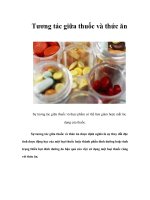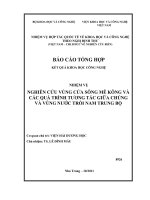Tương tác giữa PHP và jQuery - part 9 doc
Bạn đang xem bản rút gọn của tài liệu. Xem và tải ngay bản đầy đủ của tài liệu tại đây (622.85 KB, 10 trang )
CHAPTER 2 ■ COMMON JQUERY ACTIONS AND METHODS
81
This results in the paragraph’s contents being replaced with new content from ajax.php (see
Figure 2-23).
Figure 2-23. The result of an AJAX call after setting default options
These defaults can be overwritten in subsequent calls to $.ajax() by simply redefining the option in
the new call:
$.ajax({
"type":"GET",
"data":{
"newvar1":"value3",
"newvar2":"value4"
}
});
This results in the data being sent using GET (see Figure 2-24).
CHAPTER 2 ■ COMMON JQUERY ACTIONS AND METHODS
82
Figure 2-24. The result after overriding the default type option with GET
Using Shorthand AJAX Methods
There are several simple, one-use functions, available for performing common AJAX tasks. In a nutshell,
these shorthand methods are simply wrapper functions that call $.ajax() with some of the parameters
already set.
Using these methods will incur a slight performance penalty, since you’re essentially calling a
method that sets up parameters and calls $.ajax() within itself. However, the convenience of using
shorthand methods really speeds up development in many scripts.
$.get() and $.post()
For standard GET and POST requests, the $.get() and $.post() functions are easy to use. Both take four
arguments: the URL to which the request is to be sent, optional data to be sent to the remote script, an
optional callback to be executed if the request is successful, and an optional dataType setting.
To load the result of ajax.php using GET with no data sent, use the following:
$.get("ajax.php", function(data){
$("#bar")
.css("background","yellow")
.html(data);
});
CHAPTER 2 ■ COMMON JQUERY ACTIONS AND METHODS
83
To send a request with data using POST, the following code could be used:
$.post("ajax.php", {"var1":"value"}, function(data){
$("#bar")
.css("background","yellow")
.html(data);
});
$.getJSON()
When loading JSON data, $.getJSON() is a shortcut function. It accepts the URL to which requests are
sent, optional data, and an optional callback function.
To run an example of this function, another test file needs to be created: create a new file called
json.php in the testing folder, and insert the following JSON into it:
{"var1":"value1","var2":"value2"}
Now, load the contents of json.php and output the contents in the paragraph with ID bar:
$.getJSON("json.php",
function(data){
$("#bar")
.css("background","yellow")
.html(data.var1+", "+data.var2);
});
Upon execution, the contents of the paragraph will be replaced with the string "value1, value2".
$.getScript()
To load external JavaScript, use the $.getScript() function. This accepts a URL to which the request is
sent and an optional callback (which is generally not needed, as the script will execute automatically on
a successful load).
Create a new file called script.php in the testing folder, and insert the following:
alert("This script was loaded by AJAX!");
Now, load this script by executing the following code in the console:
$.getScript("script.php");
Upon execution, the alert fires.
.load()
The .load() method works just like $.get() or $.post(), except it’s a method instead of a global
function. It has an implicit callback, which is to replace the HTML of the matched elements with the
content returned from the remote file.
The method accepts the same three arguments: destination URL, optional data, and an optional
callback (which fires after the element content has been replaced).
Load the contents of ajax.php in the paragraph with ID bar after sending some data using this code:
CHAPTER 2 ■ COMMON JQUERY ACTIONS AND METHODS
84
$("#bar").load("ajax.php", {"var1":"value1"});
After running this snippet, the content of the paragraph is replaced with the returned result.
Summary
This chapter was intense and covered an awful lot of ground. Remember to check the jQuery API
documentation online for more examples, further explanation, and discussion by other developers in
the community. To search a method, simply add its name to the end of the API’s URL; for instance, to
look up the .slideup() method, navigate to in your browser.
In the next part of this book, you’ll brush up on your PHP skills, including object-oriented
programming, before jumping into the backend development of the events calendar you’ll be building
from Chapter 4 on.
P A R T 2
■ ■ ■
Getting Into Advanced PHP
Programming
At this point, you’re going to put your new jQuery knowledge aside for a bit and focus
on the backend using PHP. Part 2 teaches you how to plan and implement an object-
oriented backend solution for an events calendar that you will later enhance using
your new knowledge of jQuery. This book assumes you have a reasonably sound grasp
on the basic concepts of PHP (variables, functions, the basic language constructs); to
brush up on your PHP basics, check out PHP for Absolute Beginners (Apress, 2009).
C H A P T E R 3
■ ■ ■
87
Object-Oriented Programming
In this chapter, you'’ll learn the concepts behind object-oriented programming (OOP), a style of coding
in which related actions are grouped into classes to aid in creating more-compact, effective code.
The backend of the project you’ll be building in this book is heavily based on OOP, so the concepts
covered in this chapter will be referenced often throughout the rest of the exercises you’ll complete.
Understanding Object-Oriented Programming
As stated above, object-oriented programming is a style of coding that allows developers to group
similar tasks into classes. This helps keep code following the tenant “don’t repeat yourself” (DRY) and
easy-to-maintain.
■ Note For further reading on DRY programming, see
One of the major benefits of DRY programming is that, if a piece of information changes in your
program, usually only one change is required to update the code. One of the biggest nightmares for
developers is maintaining code where data is declared over and over again, meaning any changes to the
program become an infinitely more frustrating game of Where’s Waldo? as they hunt for duplicated data
and functionality.
OOP is intimidating to a lot of developers because it introduces new syntax and, at a glace, appears
to be far more complex than simple procedural, or inline, code. However, upon closer inspection, OOP
is actually a very straightforward and ultimately simpler approach to programming.
Understanding Objects and Classes
Before you can get too deep into the finer points of OOP, a basic understanding of the components of
objects and classes is necessary. This section will go over the building blocks of classes, their different
capabilities, and some of their uses.
CHAPTER 3 ■ OBJECT-ORIENTED PROGRAMMING
88
Recognizing the Differences Between Objects and Classes
Right off the bat, there’s confusion in OOP: seasoned developers start talking about objects and classes,
and they appear to be interchangeable terms. This is not the case, however, though the difference can be
tough to wrap your head around at first.
A class, for example, is like a blueprint for a house. It defines the shape of the house on paper, with
relationships between the different parts of the house clearly defined and planned out, even though the
house doesn’t exist.
An object, then, is like the actual house built according to that blueprint. The data stored in the
object is like the wood, wires, and concrete that compose the house: without being assembled according
to the blueprint, it’s just a pile of stuff. However, when it all comes together, it becomes an organized,
useful house.
Classes form the structure of data and actions and use that information to build objects. More than
one object can be built from the same class at the same time, each one independent of the others.
Continuing with our construction analogy, it’s similar to the way an entire subdivision can be built from
the same blueprint: 150 different houses that all look the same but have different families and
decorations inside.
Structuring Classes
The syntax to create a class is pretty straightforward: declare a class using the class keyword, followed by
the name of the class and a set of curly braces ({}):
<?php
class MyClass
{
// Class properties and methods go here
}
?>
After creating the class, a new class can be instantiated and stored in a variable using the new
keyword:
$obj = new MyClass;
To see the contents of the class, use var_dump():
var_dump($obj);
Try out this process by putting all the preceding code in a new file called test.php in the testing
folder:
<?php
class MyClass
{
// Class properties and methods go here
}
CHAPTER 3 ■ OBJECT-ORIENTED PROGRAMMING
89
$obj = new MyClass;
var_dump($obj);
?>
Load the page in your browser at http://localhost/testing/test.php and the following should
display:
object(MyClass)#1 (0) { }
In its simplest form, you’ve just completed your first OOP script.
Defining Class Properties
To add data to a class, properties, or class-specific variables, are used. These work exactly like regular
variables, except they’re bound to the object and therefore can only be accessed using the object.
To add a property to MyClass, add the following bold code to your script:
<?php
class MyClass
{
public $prop1 = "I'm a class property!";
}
$obj = new MyClass;
var_dump($obj);
?>
The keyword public determines the visibility of the property, which you’ll learn about a little later in
this chapter. Next, the property is named using standard variable syntax, and a value is assigned (though
class properties do not need an initial value).
To read this property and output it to the browser, reference the object from which to read and the
property to be read:
echo $obj->prop1;
Because multiple instances of a class can exist, if the individual object is not referenced, the script
would be unable to determine which object to read from. The use of the arrow (->) is an OOP construct
that accesses the contained properties and methods of a given object.
Modify the script in test.php to read out the property rather than dumping the whole class by
modifying the line in bold:
<?php
CHAPTER 3 ■ OBJECT-ORIENTED PROGRAMMING
90
class MyClass
{
public $prop1 = "I'm a class property!";
}
$obj = new MyClass;
echo $obj->prop1;
?>
Reloading your browser now outputs the following:
I'm a class property!
Defining Class Methods
Methods are class-specific functions. Individual actions that an object will be able to perform are
defined within the class as methods.
For instance, to create methods that would set and get the value of the class property $prop1, add
the following bold lines to your code:
<?php
class MyClass
{
public $prop1 = "I'm a class property!";
public function setProperty($newval)
{
$this->prop1 = $newval;
}
public function getProperty()
{
return $this->prop1 . "<br />";
}
}
$obj = new MyClass;
echo $obj->prop1;
?>









